Lewis gun
| Lewis Gun | |
|---|---|
 List of parts | |
| Type | Light machine gun |
| Place of origin | United States and United Kingdom |
| Service history | |
| In service | 1914–1953 |
| Used by | See Users |
| Wars |
First World War Emu War Banana Wars Irish War of Independence Irish Civil War Latvian War of Independence Second World War Korean War Malayan Emergency 1948 Arab–Israeli War The Troubles and other conflicts |
| Production history | |
| Designer |
Samuel McClean Colonel Isaac Newton Lewis The Birmingham Small Arms Company Limited |
| Designed | 1911 |
| Manufacturer |
The Birmingham Small Arms Company Limited or BSA Savage Arms Co. |
| Produced | 1913–1942 |
| Variants |
Mks I–V Aircraft Pattern Anti-Aircraft configuration Light Infantry Pattern Savage M1917 |
| Specifications | |
| Weight | 28 pounds (13 kg) |
| Length | 50.5 inches (1,280 mm) |
| Barrel length | 26.5 inches (670 mm) |
| Width | 4.5 inches (110 mm) |
|
| |
| Cartridge |
.303 British .30-06 Springfield 7.92×57mm Mauser |
| Action | Gas-operated |
| Rate of fire | 500–600 rounds/min |
| Muzzle velocity | 2,440 feet per second (740 m/s) |
| Effective firing range | 880 yards (800 m) |
| Maximum firing range | 3,500 yards (3,200 m) |
| Feed system | 47- or 97-round pan magazine |
| Sights | Blade and tangent leaf |
The Lewis gun (or Lewis automatic machine gun or Lewis automatic rifle) is a First World War-era light machine gun of US design that was perfected and mass-produced in the United Kingdom,[1] and widely used by British and British Empire troops during the war. With its distinctive barrel cooling shroud and top mounted pan magazine, the Lewis saw service to the end of the Korean War. It was also widely used as an aircraft machine gun, almost always with the cooling shroud removed, during both world wars.
History
The Lewis gun was invented by U.S. Army colonel Isaac Newton Lewis in 1911, based on initial work by Samuel Maclean.[2] Despite its origins, the Lewis gun was not initially adopted by the US military, most likely because of political differences between Lewis and General William Crozier, the Chief of the Ordnance Department.[3] Lewis became frustrated with trying to persuade the U.S. Army to adopt his design and so ("slapped by rejections from ignorant hacks", as he said),[4] retired from the army. He left the United States in 1913 and went to Belgium, where he established the Armes Automatique Lewis company in Liège to facilitate commercial production of the gun.[5] Lewis had been working closely with British arms manufacturer The Birmingham Small Arms Company Limited (BSA) in an effort to overcome some of the production difficulties of the weapon.[2] The Belgians bought a small number of Lewises in 1913, using the .303 British round and, in 1914, BSA purchased a licence to manufacture the Lewis machine gun in England, which resulted in Col. Lewis receiving significant royalty payments and becoming very wealthy.[4] Lewis and his factory moved to England before 1914, away from possible seizure in the event of a German invasion. The Belgian army acquired only a handful of his guns. They were not on general issue in the Belgian Army, and were used only in a few forays by motor vehicles, south of Antwerp, against the flank of the invading German Army.
The onset of the First World War increased demand for the Lewis gun, and BSA began production (under the designation Model 1914). The design was officially approved for service on 15 October 1915 under the designation "Gun, Lewis, .303-cal."[6] No Lewis guns were produced in Belgium during the war;[7] all manufacture was carried out by BSA in England and the Savage Arms Company in the US.[8]

Production
The Lewis was produced by BSA and Savage Arms during the war, and although the two versions were largely similar, there were enough differences to stop them being completely interchangeable, although this was rectified by the time of the Second World War.[9]
The major difference between the two designs was that the BSA weapons were chambered for .303 British ammunition but the Savage guns were chambered for .30-06 cartridges, which necessitated some difference in the magazine, feed mechanism, bolt, barrel, extractors and gas operation system.[8] Savage did make Lewis Guns in .303 British calibre, though. The Model 1916 and Model 1917 were exported to Canada and the United Kingdom and a few were supplied to the US military, particularly the Navy.[8] The Savage Model 1917 was generally produced in .30-06 caliber. A number of these guns were supplied to the UK under lend-lease during the Second World War.[10]
Design details
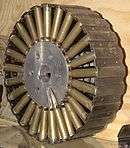
The Lewis gun was gas operated. A portion of the expanding propellant gas was tapped off from the barrel, driving a piston to the rear against a spring. The piston was fitted with a vertical post at its rear which rode in a helical cam track in the bolt, rotating it at the end of its travel nearest the breech. This allowed the three locking lugs at the rear of the bolt to engage in recesses in the gun's body to lock it into place. The post also carried a fixed firing pin, which protruded through an aperture in the front of the bolt, firing the next round at the foremost part of the piston's travel.[11][12]

The gun's aluminium barrel-shroud caused the muzzle blast to draw air over the barrel and cool it, due to the radially-finned aluminum heat sink within the shroud's barrel, running lengthwise in contact with the gun barrel from the "bottleneck" near the shroud's muzzle end and protruding externally behind the shroud's rear end. There is some discussion over whether the shroud was really necessary—in the Second World War, many old aircraft guns that did not have the tubing were issued to anti-aircraft units of the British Home Guard and to British airfields, and others were used on vehicle mounts in the Western Desert; all were found to function properly without it, which led to the suggestion that Lewis had insisted on the cooling arrangement largely to show that his design was different from Maclean's earlier prototypes.[13] Only the Royal Navy retained the tube on their deck-mounted AA-configuration Lewis guns.[14]
The Lewis gun used a pan magazine holding 47 or 97 rounds.[15] Pan magazines hold the rounds, bullet-noses inwards toward the center, in a radial fan. Unlike the more common drum magazines, which hold the rounds parallel to the axis and are fed by spring tension, pan magazines are mechanically indexed. The Lewis magazine was driven by a cam on top of the bolt which operated a pawl mechanism via a lever.[12]
An interesting point of the design was that it did not use a traditional helical coiled recoil spring, but used a spiral spring, much like a large clock spring, in a semicircular housing just in front of the trigger. The operating rod had a toothed underside, which engaged with a cog which wound the spring. When the gun fired, the bolt recoiled and the cog was turned, tightening the spring until the resistance of the spring had reached the recoil force of the bolt assembly. At that moment, as the gas pressure in the breech fell, the spring unwound, turning the cog, which, in turn, wound the operating rod forward for the next round. As with a clock spring, the Lewis gun recoil spring had an adjustment device to alter the recoil resistance for variations in temperature and wear. Unusual as it seems, the Lewis design proved reliable and was even copied by the Japanese and used extensively by them during the Second World War.[16]
The gun's cyclic rate of fire was approximately 500–600 rounds per minute. It weighed 28 lb (12.7 kg), only about half as much as a typical medium machine gun of the era, such as the Vickers machine gun, and was chosen in part because, being more portable than a heavy machine gun, it could be carried and used by one soldier.[17] BSA even produced at least one model (the "B.S.A. Light Infantry Pattern Lewis Gun", which lacked the aluminium barrel shroud and had a wooden fore grip) designed as a form of assault weapon.[18]
Service

First World War
The first use of the Lewis in the War was by Belgium, in August and September 1914, when the small number available were fitted to a handful of touring and armoured cars and used in a few sorties against German patrols and troop columns. It is stated that, as a consequence, the Germans nicknamed the Lewis "The Belgian Rattlesnake".,[19] but contemporary German references have not been found. The Lewis was not in service with the regular Belgian Army.
Great Britain officially adopted the Lewis gun in .303 calibre for land and aircraft use in October 1915,[20] with the weapon beginning to be generally issued to the British Army's infantry battalions on the Western Front in early 1916 as a replacement for the heavier and less mobile Vickers machine gun, the Vickers then being withdrawn from the infantry for use by specialist machine-gun companies. The US Navy and Marine Corps followed in early 1917, adopting the M1917 Lewis gun (produced by the Savage Arms Co.), in .30-06 caliber.
The US Army never officially adopted the weapon for infantry use[14] and even went so far as to take Lewis guns away from US Marines arriving in France and replace them with the cheap, shoddy, and extremely unsatisfactory Chauchat LMG[21]—a practice believed to be related to General Crozier's dislike of Lewis and his gun.[22] The US Army eventually adopted the Browning Automatic Rifle in 1917 (although it was September 1918 before any of the new guns reached the front).[23] The US Navy and Marine Corps continued to use the .30-06 caliber Lewis until the early part of the Second World War.[24]

The Russian Empire purchased 10,000 Lewis guns in 1917 from the British government, and ordered another 10,000 weapons from Savage Arms in the US. The US government was unwilling to supply the Tsarist Russian government with the guns and there is some doubt as to whether they were actually delivered, although records indicate that 5,982 Savage weapons were delivered to Russia by 31 March 1917. The Lewis guns supplied by Britain were dispatched to Russia in May 1917, but it is not known for certain whether these were the Savage-made weapons being trans-shipped through the UK, or a separate batch of UK-produced units.[25]
British Mark IV tanks used the Lewis, replacing the Vickers and Hotchkiss used in earlier tanks. The Lewis was chosen for its relatively compact magazines, but as soon as an improved magazine belt for the Hotchkiss was developed, the Lewis was replaced by them in later tank models.[26]
The Germans also used captured Lewis guns in both World Wars, and included instruction in its operation and care as part of their machine-gun crew training.[19]
Despite costing more than a Vickers gun to manufacture (the cost of a Lewis gun in 1915 was £165,[6] the Vickers cost about £100),[23] Lewis machine guns were in high demand with the British military during the First World War. The Lewis also had the advantage of being about 80% faster to build than the Vickers, and was a lot more portable.[27] Accordingly, the British government placed orders for 3,052 guns between August 1914 and June 1915.[6] By the end of the war, over 50,000 Lewis guns had been produced in the US and UK and they were nearly ubiquitous on the Western Front, outnumbering the Vickers by a ratio of about 3:1.[23]
Aircraft use

The Lewis gun has the distinction of being the first machine gun fired from an aeroplane; on 7 June 1912, Captain Charles Chandler of the US Army fired a prototype Lewis gun from the foot-bar of a Wright Model B Flyer.[19]
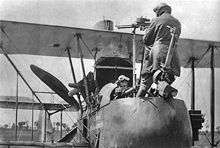
The Lewis gun was extensively used on British and French aircraft during the First World War, as either an observer's or gunner's weapon or an additional weapon to the more common Vickers. The Lewis's popularity as an aircraft machine gun was partly due to its low weight, the fact that it was air-cooled and that it used self-contained 97-round drum magazines. Because of this, the Lewis was first mounted on the Vickers F.B.5 "Gunbus", probably the world's first purpose-built combat aircraft, when it entered service in August 1914, replacing the Vickers machine gun used on earlier experimental versions.[28] It was also fitted on two early production examples of the Bristol Scout C aircraft by Lanoe Hawker in the summer of 1915, mounted on the port side and firing forwards and outwards at a 30° angle to avoid the propeller arc.
The need for forward-aimed aircraft mounts for the Lewis gun to avoid firing through the propeller arc on single-engined fighters resulted from the open bolt firing cycle of the Lewis, which prevented it from being synchronized to fire directly forward through the propeller arc of such aircraft; only the British F.B.5, Airco D.H.2 and Royal Aircraft Factory F.E.8 pusher fighters could readily use the Lewis as direct forward-firing armament early in the war. British single-engined fighters could use the Foster mounting to elevate a Lewis gun above the propeller arc for unsynchronized firing, as was used on production S.E.5a fighters and on field-modified examples of the Avro 504. For the use of observers or rear gunners, the Lewis was mounted on a Scarff ring, which allowed the gun to be rotated and elevated whilst supporting the gun's weight.[29]
Until September 1916 Zeppelin airships were very difficult to attack successfully at high altitude, although this also made accurate bombing impossible. Aeroplanes struggled to reach a typical altitude of 10,000 feet (3,000 m), and firing the solid bullets usually used by aircraft Lewis guns was ineffectual: they made small holes causing inconsequential gas leaks. Britain developed new bullets, the Brock containing inflammable potassium chlorate,[30] and the Buckingham filled with phosphorus,[31] to ignite the potassium chlorate and hence the Zeppelin's hydrogen. These had become available by September 1916.[32] They proved very successful, and Lewis guns loaded with a mixture of Brock and Buckingham ammunition were often employed for balloon-busting against German Zeppelins, other airships and Drache barrage balloons.[19]
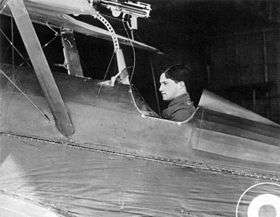

Later, on the French Nieuport 11 and Nieuport 17 and the British S.E.5a and some versions of the Sopwith Camel and Bristol F2b fighter aircraft, the Lewis was fitted above the top wing on a Foster mount, which allowed firing directly forward outside the propeller arc. The Foster mount usually incorporated an arc-shaped I-beam rail as its rearmost structural member, that a Lewis gun could be slid backwards and downwards along the rail towards the cockpit, to allow the ammunition drum to be changed in flight — but fighter ace Albert Ball V.C. also understood that the Lewis gun in such a mount also retained its original trigger, and could thus be fired upwards. He used the upward firing Lewis to attack solitary German two-seater aircraft from below and behind, where the observer could not see him or fire back. It was his use of the weapon in this way, in a Nieuport, that led to its later introduction on the S.E.5/S.E.5a. Ball had acted in a consultant capacity on the development of this aeroplane. The later Sopwith Dolphin, already armed with twin synchronized Vickers guns just forward of the pilot and just above its V-8 engine, could also use one or two Lewis guns mounted on the forward crossbar of its cabane structure, between the top wing panels, as an anti-Zeppelin measure.
Lewis guns were also carried as defensive guns on British airships. The SS class blimps carried one gun. The larger NS class blimps carried two or three guns in the control car and some were fitted with an additional gun and a gunner's position at the top of the gasbag.[33]
Second World War
.jpg)
By the Second World War, the British Army had replaced the Lewis gun with the Bren gun for most infantry use. As an airborne weapon, the Lewis was largely supplanted by the Vickers K, a weapon that could achieve over twice the rate of fire of the Lewis.
In the crisis following the Fall of France, where a large part of the British Army's equipment had been lost, stocks of Lewis guns in both .303 and .30-06 were hurriedly pressed into service, primarily for Home Guard, airfield defense and anti-aircraft use.[34] 58,983 Lewis guns were taken from stores, repaired, refitted and issued by the British during the course of the war.[35] In addition to their reserve weapon role in the UK, they also saw front-line use with British, Australian, and New Zealand forces in the early years of the Pacific campaign against the Japanese.[36] The Lewis gun saw continued service as an anti-aircraft weapon during the war; in this role it was credited by the British for bringing down more low-flying enemy aircraft than any other AA weapon.[37]
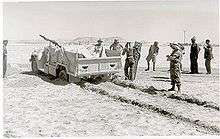
At the start of the Second World War, the Lewis was the Royal Navy's standard close-range air defence weapon. It could be found on major warships, armed trawlers and defensively equipped merchant ships. It was often used in twin mountings and a quadruple mount was developed for motor torpedo boats. British submarines generally carried two guns on single mounts. Although it was gradually replaced by the Oerlikon 20 mm cannon, new corvettes were still being fitted with twin Lewises as late as 1942. Lewis guns were also carried by the Royal Air Force's air-sea rescue launches.[38]

American forces used the Lewis gun (in .30-06 caliber) throughout the war. The US Navy used the weapon on armed merchant cruisers, small auxiliary ships, landing craft and submarines. The US Coast Guard also used the Lewis on their vessels.[37] It was never officially adopted by the US Army for anything other than aircraft use.[14]
The Germans used captured British Lewis guns during the war under the designation MG 137(e),[39] whilst the Japanese copied the Lewis design and employed it extensively during the war;[37] it was designated the Type 92 and chambered for a 7.7 mm rimmed cartridge that was interchangeable with the .303 British round.[40][41]
The Lewis was officially withdrawn from British service in 1946,[23] but continued to be used by forces operating against the United Nations in the Korean War. It was also used against French and US forces in the First Indochina War and the subsequent Vietnam War.[42]
Total production of the Lewis gun during the Second World War by BSA was over 145,000 units,[14] a total of 3,550 guns were produced by the Savage Arms Co. for US service—2,500 in .30-06 and 1,050 in .303 British calibre.[24]
Variants
British service

- Mark I. The 0.303 Lewis Mk I was the basic ground pattern model used by British and British Empire forces from 1915 with few improvements.[43]
- Mark II. This was the first purpose built aircraft version of the Lewis, earlier versions had been improvised from Mk I guns. The cooling fins were omitted to save weight, but a light protective shroud around the barrel was retained. The wooden stock was removed and replaced with a "spade" grip, which resembled the handle of a garden spade. A 97-round drum magazine was introduced which required a larger magazine spigot on the body of the gun.
- Mark II*. An improved Mk II with an increased rate of fire introduced in 1918.
- Mark III. A further upgrade of the Mk II with an even faster rate of fire and the barrel shroud deleted, introduced later in 1918.[44]
- Mark III*. The British designation for the US .30-06 M1918 aircraft gun, some 46,000 of which were imported for the use of the Home Guard in 1940. These guns were modified for ground use by the replacement of the spade grip with a crude skeleton stock and the addition of a simple wooden fore-stock which would allow the gun to be fired while resting on a sandbag, or from the hip while advancing.
- Mark III**. The designation for the .303 Mark III modified in the same way as the US M1918s.
- Mark III DEMS. Intended for Defensively Equipped Merchant Ships (DEMS), it was similar to the Mk III** but with the addition of a pistol grip on the fore-stock, so that the weapon could be fired free-standing from the shoulder, from any part of a ship's decks.
- Mark IV. After all the usable weapons had been reconditioned and issued, there remained a large number of incomplete Lewis guns and spare parts. These were assembled into guns similar to the Mk III**. There was a particular shortage of the fragile "clock" springs for the Lewis, so a simpler spring was manufactured and housed in a straight tube which extended into the skeleton stock. Many of these guns were fitted with a simple and light tripod which had been specially produced.[45]
Canadian service
- Model 1915. This was the designation given to .303 Lewis Mk I weapons manufactured for Canada in the USA by the Savage Arms Company. Large numbers of these guns were also produced by Savage for the British Army and in an aircraft configuration, for France and Italy.[46]
US Service
- M1917 Lewis. Savage produced a version of the Lewis Mk I for US forces, rechambered for the .30-06 round and with a modified gas operation due to the greater power of the US ammunition. A majority of these were modified for aircraft use. The US Navy designation was Lewis Mark IV.
- M1918 Lewis. A purpose built aircraft version of the M1917.
Other users
There was also a Fremdgerät number for a Leichte MG 107(f), with the original name given as "Fusil-mitrailleur «Lewis» mle 1924", chambered in either 8×50mmR Lebel or in 6.5×55mm Mauser and manufactured by Societe d'Armes Lewis at Saint-Denis; the firing rate given was 450-rounds per minute.[47] One book lists this "Fusil-mitrailleur «Lewis» mle 1924" as a French Lewis gun without further details,[48] but the mechanism appears rather different.[49]
The Lewis gun was produced in Czechoslovakia, between the wars, as the vz.15 machine gun.
Experimental projects
A commercial venture in 1921 by the Birmingham Small Arms Company was a version which fired the 12.7×81mm (0.5-inch Vickers) ammunition, intended for use against aircraft and tanks. At around the same time, BSA developed the Light Infantry Model which had a 22-round magazine and a wooden fore-stock in place of the radiator fins and shroud; it was intended to be used in a similar way to the Browning Automatic Rifle. Another development was a twin Lewis for aircraft use in which the bodies of the two weapons were joined side-by-side and the drum magazines were mounted vertically, one on each side. None of these projects was accepted by any armed forces.[50]
A short-barrelled light machine gun variant was developed at the start of the Second World War. It came with a hand guard and was fed from a 30-round Bren magazines; however, it was decided by the British authorities to concentrate production on the Bren, which had the advantage of a changeable barrel.[51]
Influence on later designs
The German FG 42 paratrooper's rifle used the Lewis gun's gas assembly and bolt design which were in turn incorporated into the M60 machine gun.[42]
The Type 92 machine gun, the standard hand-held machine gun used by Imperial Japanese Navy aircraft gunners in WWII, was essentially a copy of the Lewis gun.
Users
-
 Australia
Australia -
.svg.png) Belgium
Belgium -
 Canada
Canada -
 Chile
Chile -
 Republic of China
Republic of China -
 Colombia
Colombia -
 Czechoslovakia
Czechoslovakia -
 Estonia
Estonia -
 Finland
Finland -
 France
France -
.svg.png) Democratic Republic of Georgia (Mostly People's Guard and some army units too in 1918-1921)
Democratic Republic of Georgia (Mostly People's Guard and some army units too in 1918-1921) -
 German Empire (Which found it much lighter than the MG08/15)
German Empire (Which found it much lighter than the MG08/15) -
.svg.png) Nazi Germany
Nazi Germany -
 Honduras
Honduras -
 Ireland
Ireland -
 Israel
Israel -
 Italy
Italy -
.svg.png) Empire of Japan
Empire of Japan -
 Malaya
Malaya -
.png) Mexico
Mexico -
 Netherlands
Netherlands -
 New Zealand
New Zealand -
 Newfoundland
Newfoundland -
 Nicaragua
Nicaragua -
 Norway
Norway -
 Philippines
Philippines -
 Poland
Poland -
 Portugal
Portugal -
 Russian Empire
Russian Empire -
.svg.png) Soviet Union
Soviet Union -
 Sri Lanka
Sri Lanka  Tibet
Tibet-
 United Kingdom & British Empire
United Kingdom & British Empire -
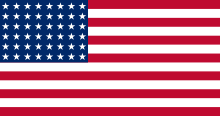 United States
United States -
 Kingdom of Yugoslavia
Kingdom of Yugoslavia -
 Latvia (standard LMG during Latvian war of independence and interwar period)
Latvia (standard LMG during Latvian war of independence and interwar period)
See also
- List of U.S. Army weapons by supply catalog designation SNL A-11
- Johnston Model D1918 machine gun
- FM 24/29 light machine gun
- Type 92 machine gun
Notes
- ↑ Easterly, p65
- 1 2 Skennerton (2001), p.5
- ↑ Ford (2005), p.67–68.
- 1 2 Ford (2005), p.68
- ↑ Hogg (1978) p. 218
- 1 2 3 Skennerton (2001) p.6
- ↑ Skennerton (2001), p.7
- 1 2 3 Skennerton (2001), p.41.
- ↑ Skennerton (2001), p.15 and 41–46.
- ↑ Skennerton (20SUHAS01), p.41 and 47.
- ↑ Ford (2005), p.68–70.
- 1 2 Smith (1943), p.31.
- ↑ Ford (2005), p.70.
- 1 2 3 4 Ford (2005), p.70
- ↑ Smith (1943), p.28 and 32.
- ↑ Smith (1943), pp.31–32.
- ↑ Hogg (1976), p.27.
- ↑ Skennerton (2001), p.4.
- 1 2 3 4 Bruce, Robert (2000). "The Lewis Gun". Guns Magazine, March 2000/findarticles.com. Retrieved 12 February 2009.
- ↑ Skennerton (2001), p.6
- ↑ Hogg (1976), p.30-31
- ↑ Hogg (1976), p.31
- 1 2 3 4 Ford (2005), p.71
- 1 2 Smith (1973), p.270
- ↑ Skennerton (2001), p.46
- ↑ Glanfield (2001)
- ↑ Hogg (1976), p.27
- ↑ Hugh Driver, The Birth of Military Aviation: Britain, 1903–1914, The Boydell Press 1997, ISBN 978-0-86193-234-4 (p.126). Retrieved 27 November 2014.
- ↑ Hogg (1976), pp.27, 33
- ↑ ".303 inch Explosive". British Military Small Arms Ammo - Brock. Retrieved 3 September 2016.
- ↑ ".303 inch Incendiary - Buckingham". British Military Small Arms Ammo. Retrieved 3 September 2016.
- ↑ "Leefe Robinson: The man who shot down a Baby Killer". BBC News. 3 September 2016.
- ↑ Abbott, Patrick (1989). The British Airship at War 1914–1918. Lavenham, Suffolk: Terence Dalton Ltd. p. 78. ISBN 0-86138-073-8.
- ↑ Skennerton (1988), p.58
- ↑ Skennerton (2001), p.46–47
- ↑ Skennerton (2001), pp.7–9
- 1 2 3 Smith (1943), p. 32
- ↑ John Lambert and Al Ross, Allied Coastal Forces of World War II: Vol. 1, Fairmile designs and US submarine chasers, Conway Maritime Press 1990, ISBN 0-85177-519-5 (pp.196-200). Retrieved 27 November 2014.
- ↑ Chant (2001), p.47
- ↑ Smith (1973), p.512
- ↑ Smith (1943), p.131
- 1 2 3 Skennerton (2001), p. 9
- ↑ Grant (2001) pp. 14-15
- ↑ Grant (2001) pp. 17-18
- ↑ Grant (2001) p. 63
- ↑ Grant (2014) p. 16
- ↑ img246.imageshack.us/img246/1087/lewis24.jpg
- ↑ Machine guns, World War II fact files by Peter Chamberlain, Terry Gander Arco Pub. Co., 1974, ISBN 0668036087, pp. 44-45
- ↑ forums.gunboards.com/showthread.php?209355-Lewis-automatic-rifle
- ↑ Grant (2001) p. 26
- ↑ Grant (2001) p. 42
References
- Chant, Christopher (2001). Small Arms Of World War II. London (UK): Brown Partworks. ISBN 1-84044-089-9.
- Ford, Roger (2005). The World's Great Machine Guns from 1860 to the Present Day. London (UK): Amber Books. ISBN 1-84509-161-2.
- Glanfield, John (2001). The Devil's Chariots - The birth and secret battles of the first tanks. Stroud (UK): Sutton Publishing. ISBN 0-7509-4152-9.
- Grant, Neil (2014). The Lewis Gun. Oxford (UK): Osprey Publishing. ISBN 978-1782007913.
- Hogg, Ian V. (1978). The Complete Illustrated Encyclopedia of the World's Firearms. A&W Publishers. ISBN 978-0-89479-031-7.
- Hogg, Ian V., and Batchelor, John (1976). The Machine-Gun (Purnell's History of the World Wars Special). London (UK): Phoebus Publishing.
- Skennerton, Ian (1988). British Small Arms of World War 2. Margate QLD (Australia): Ian Skennerton. ISBN 0-949749-09-5.
- Skennerton, Ian (2001). Small Arms Identification Series No. 14:.303 Lewis Machine Gun. Gold Coast QLD (Australia): Arms & Militaria Press. ISBN 0-949749-42-7.
- Smith, Joseph E. (1973). Small Arms Of The World (10th Revised Edition). Harrisburg PA (USA): Stackpole Books. ISBN 0-88365-155-6.
- Smith, W.H.B. (1979) [1943]. 1943 Basic Manual of Military Small Arms (Facsimile Edition). Harrisburg PA (USA): Stackpole Books. ISBN 0-8117-1699-6.
- Townsend, Reginald T. (December 1916). ""Tanks" And "The Hose Of Death"". The World's Work: A History of Our Time. XXXIII: 195–207. Retrieved 2009-08-04.
- War Office (1929 (1999 reprint)). Textbook of Small Arms 1929. London (UK), Dural (NSW): H.M.S.O/Rick Landers.
Further reading
- William McCleave Easterly (1998). The Belgian Rattlesnake: The Lewis Automatic Machine Gun : a Social and Technical Biography of the Gun and Its Inventors. Collector Grade Publications. p. 542. ISBN 978-0-88935-236-0.
External links
| Wikimedia Commons has media related to Lewis Gun. |
- Scans of Lewis gun manual of 1917
- Lewis light machine gun (USA - Great Britain) at Modern Firearms
- Animation of Lewis machine gun 1916
- Lewis gun with cooling shroud in demonstration firing